Case Study Using Clinical Reasoning Analysis
VerifiedAdded on 2023/04/21
|8
|2362
|436
AI Summary
This case study explores the process of using clinical reasoning analysis to provide effective care for a patient with asthma. It discusses the collection and interpretation of patient data, identifies nursing problems, sets goals, and outlines actions to achieve those goals. The importance of proper patient engagement and therapeutic communication is highlighted, along with the need for informed consent. The case study emphasizes the significance of addressing low oxygen saturation and provides recommendations for improving nursing performance.
Contribute Materials
Your contribution can guide someone’s learning journey. Share your
documents today.
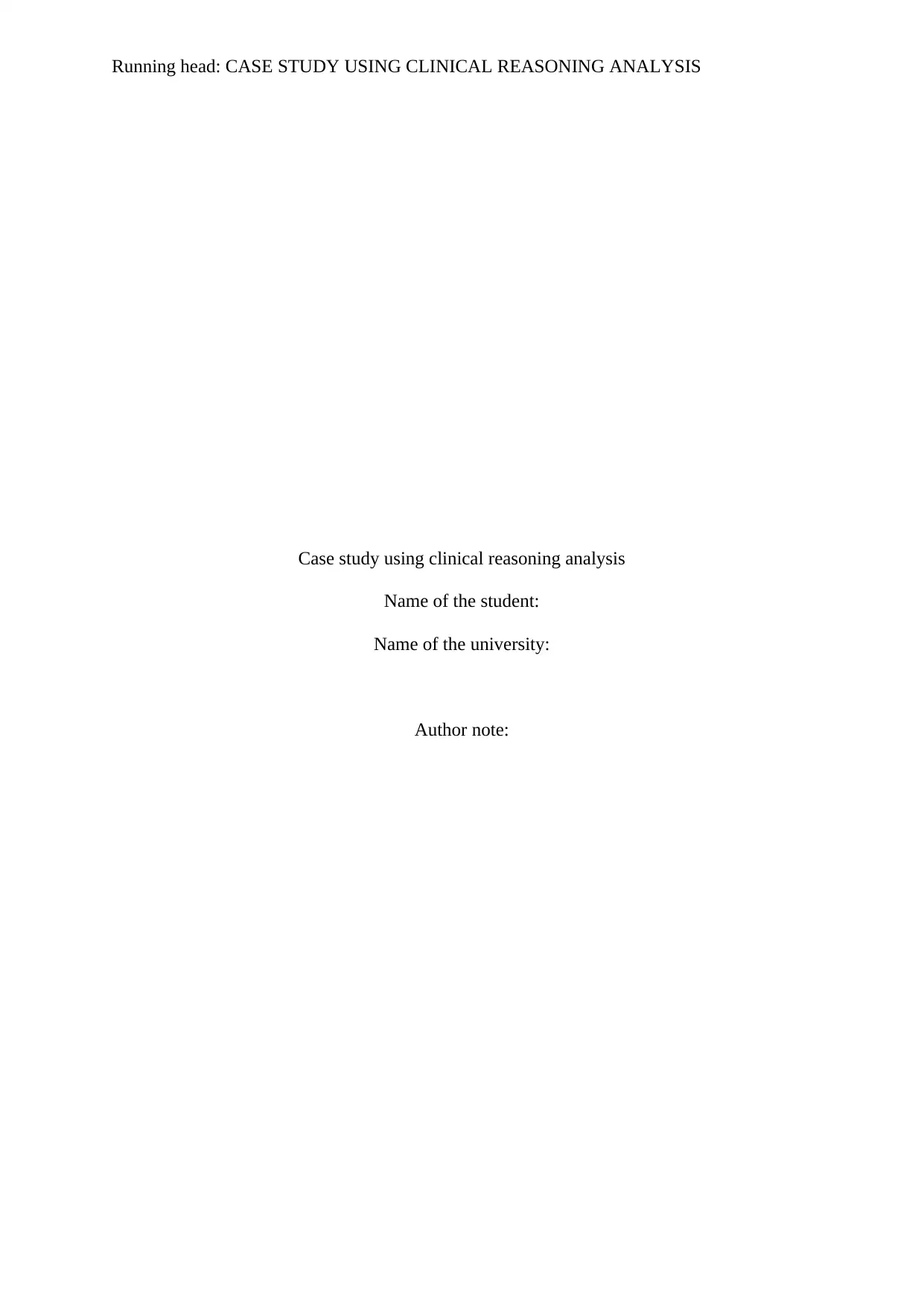
Running head: CASE STUDY USING CLINICAL REASONING ANALYSIS
Case study using clinical reasoning analysis
Name of the student:
Name of the university:
Author note:
Case study using clinical reasoning analysis
Name of the student:
Name of the university:
Author note:
Secure Best Marks with AI Grader
Need help grading? Try our AI Grader for instant feedback on your assignments.
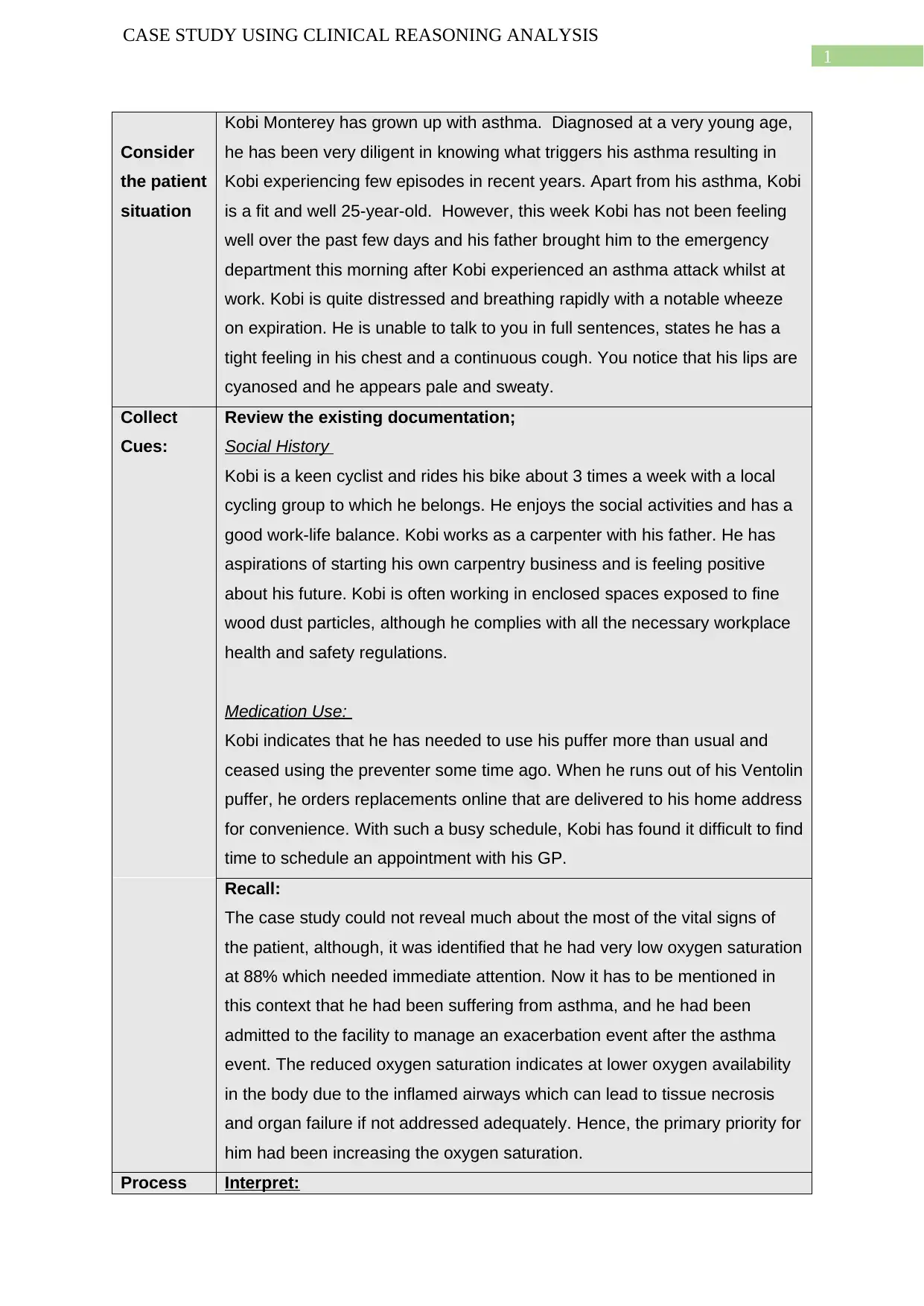
1
CASE STUDY USING CLINICAL REASONING ANALYSIS
Consider
the patient
situation
Kobi Monterey has grown up with asthma. Diagnosed at a very young age,
he has been very diligent in knowing what triggers his asthma resulting in
Kobi experiencing few episodes in recent years. Apart from his asthma, Kobi
is a fit and well 25-year-old. However, this week Kobi has not been feeling
well over the past few days and his father brought him to the emergency
department this morning after Kobi experienced an asthma attack whilst at
work. Kobi is quite distressed and breathing rapidly with a notable wheeze
on expiration. He is unable to talk to you in full sentences, states he has a
tight feeling in his chest and a continuous cough. You notice that his lips are
cyanosed and he appears pale and sweaty.
Collect
Cues:
Review the existing documentation;
Social History
Kobi is a keen cyclist and rides his bike about 3 times a week with a local
cycling group to which he belongs. He enjoys the social activities and has a
good work-life balance. Kobi works as a carpenter with his father. He has
aspirations of starting his own carpentry business and is feeling positive
about his future. Kobi is often working in enclosed spaces exposed to fine
wood dust particles, although he complies with all the necessary workplace
health and safety regulations.
Medication Use:
Kobi indicates that he has needed to use his puffer more than usual and
ceased using the preventer some time ago. When he runs out of his Ventolin
puffer, he orders replacements online that are delivered to his home address
for convenience. With such a busy schedule, Kobi has found it difficult to find
time to schedule an appointment with his GP.
Recall:
The case study could not reveal much about the most of the vital signs of
the patient, although, it was identified that he had very low oxygen saturation
at 88% which needed immediate attention. Now it has to be mentioned in
this context that he had been suffering from asthma, and he had been
admitted to the facility to manage an exacerbation event after the asthma
event. The reduced oxygen saturation indicates at lower oxygen availability
in the body due to the inflamed airways which can lead to tissue necrosis
and organ failure if not addressed adequately. Hence, the primary priority for
him had been increasing the oxygen saturation.
Process Interpret:
CASE STUDY USING CLINICAL REASONING ANALYSIS
Consider
the patient
situation
Kobi Monterey has grown up with asthma. Diagnosed at a very young age,
he has been very diligent in knowing what triggers his asthma resulting in
Kobi experiencing few episodes in recent years. Apart from his asthma, Kobi
is a fit and well 25-year-old. However, this week Kobi has not been feeling
well over the past few days and his father brought him to the emergency
department this morning after Kobi experienced an asthma attack whilst at
work. Kobi is quite distressed and breathing rapidly with a notable wheeze
on expiration. He is unable to talk to you in full sentences, states he has a
tight feeling in his chest and a continuous cough. You notice that his lips are
cyanosed and he appears pale and sweaty.
Collect
Cues:
Review the existing documentation;
Social History
Kobi is a keen cyclist and rides his bike about 3 times a week with a local
cycling group to which he belongs. He enjoys the social activities and has a
good work-life balance. Kobi works as a carpenter with his father. He has
aspirations of starting his own carpentry business and is feeling positive
about his future. Kobi is often working in enclosed spaces exposed to fine
wood dust particles, although he complies with all the necessary workplace
health and safety regulations.
Medication Use:
Kobi indicates that he has needed to use his puffer more than usual and
ceased using the preventer some time ago. When he runs out of his Ventolin
puffer, he orders replacements online that are delivered to his home address
for convenience. With such a busy schedule, Kobi has found it difficult to find
time to schedule an appointment with his GP.
Recall:
The case study could not reveal much about the most of the vital signs of
the patient, although, it was identified that he had very low oxygen saturation
at 88% which needed immediate attention. Now it has to be mentioned in
this context that he had been suffering from asthma, and he had been
admitted to the facility to manage an exacerbation event after the asthma
event. The reduced oxygen saturation indicates at lower oxygen availability
in the body due to the inflamed airways which can lead to tissue necrosis
and organ failure if not addressed adequately. Hence, the primary priority for
him had been increasing the oxygen saturation.
Process Interpret:
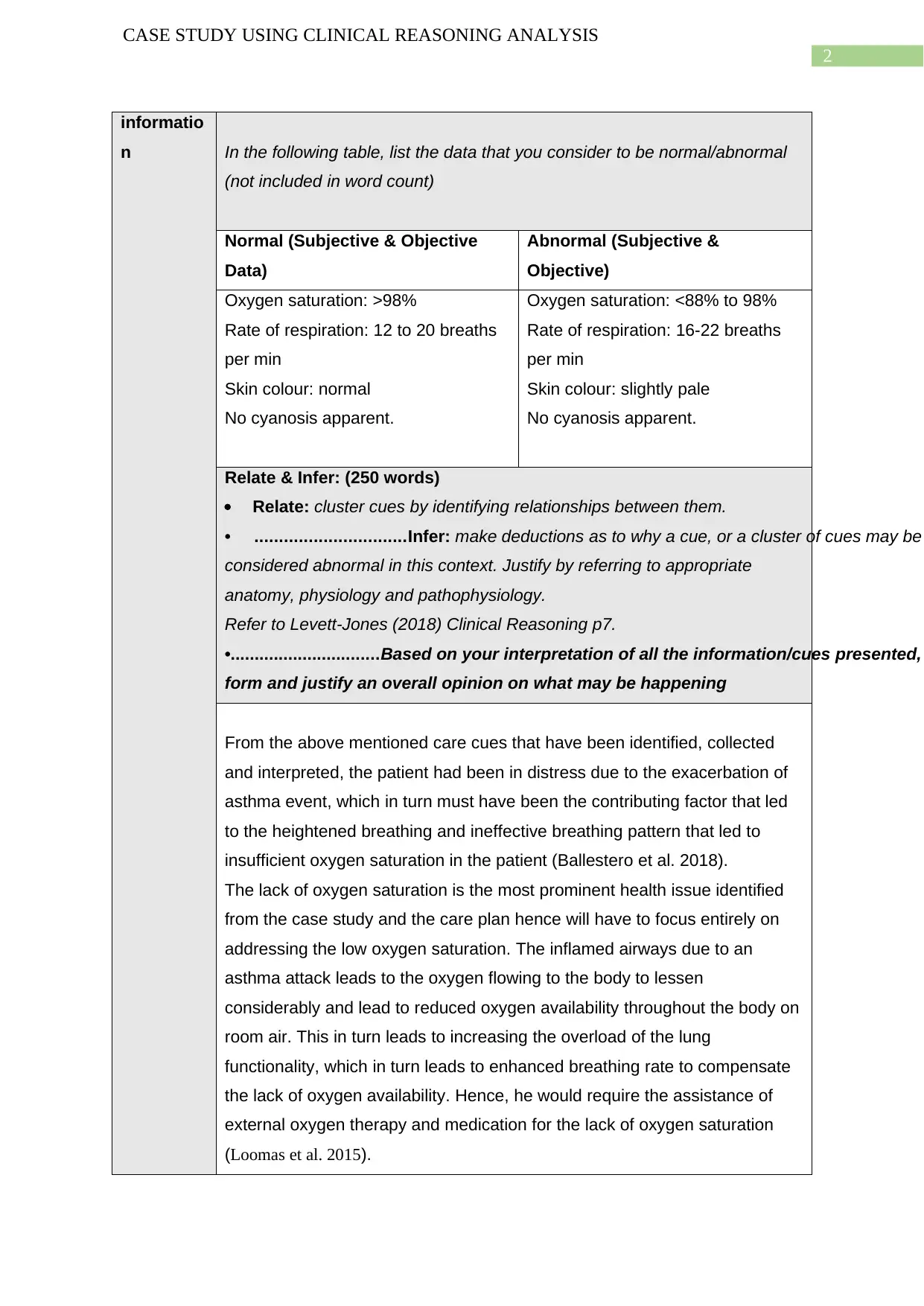
2
CASE STUDY USING CLINICAL REASONING ANALYSIS
informatio
n In the following table, list the data that you consider to be normal/abnormal
(not included in word count)
Normal (Subjective & Objective
Data)
Abnormal (Subjective &
Objective)
Oxygen saturation: >98%
Rate of respiration: 12 to 20 breaths
per min
Skin colour: normal
No cyanosis apparent.
Oxygen saturation: <88% to 98%
Rate of respiration: 16-22 breaths
per min
Skin colour: slightly pale
No cyanosis apparent.
Relate & Infer: (250 words)
Relate: cluster cues by identifying relationships between them.
• ...............................Infer: make deductions as to why a cue, or a cluster of cues may be
considered abnormal in this context. Justify by referring to appropriate
anatomy, physiology and pathophysiology.
Refer to Levett-Jones (2018) Clinical Reasoning p7.
•...............................Based on your interpretation of all the information/cues presented,
form and justify an overall opinion on what may be happening
From the above mentioned care cues that have been identified, collected
and interpreted, the patient had been in distress due to the exacerbation of
asthma event, which in turn must have been the contributing factor that led
to the heightened breathing and ineffective breathing pattern that led to
insufficient oxygen saturation in the patient (Ballestero et al. 2018).
The lack of oxygen saturation is the most prominent health issue identified
from the case study and the care plan hence will have to focus entirely on
addressing the low oxygen saturation. The inflamed airways due to an
asthma attack leads to the oxygen flowing to the body to lessen
considerably and lead to reduced oxygen availability throughout the body on
room air. This in turn leads to increasing the overload of the lung
functionality, which in turn leads to enhanced breathing rate to compensate
the lack of oxygen availability. Hence, he would require the assistance of
external oxygen therapy and medication for the lack of oxygen saturation
(Loomas et al. 2015).
CASE STUDY USING CLINICAL REASONING ANALYSIS
informatio
n In the following table, list the data that you consider to be normal/abnormal
(not included in word count)
Normal (Subjective & Objective
Data)
Abnormal (Subjective &
Objective)
Oxygen saturation: >98%
Rate of respiration: 12 to 20 breaths
per min
Skin colour: normal
No cyanosis apparent.
Oxygen saturation: <88% to 98%
Rate of respiration: 16-22 breaths
per min
Skin colour: slightly pale
No cyanosis apparent.
Relate & Infer: (250 words)
Relate: cluster cues by identifying relationships between them.
• ...............................Infer: make deductions as to why a cue, or a cluster of cues may be
considered abnormal in this context. Justify by referring to appropriate
anatomy, physiology and pathophysiology.
Refer to Levett-Jones (2018) Clinical Reasoning p7.
•...............................Based on your interpretation of all the information/cues presented,
form and justify an overall opinion on what may be happening
From the above mentioned care cues that have been identified, collected
and interpreted, the patient had been in distress due to the exacerbation of
asthma event, which in turn must have been the contributing factor that led
to the heightened breathing and ineffective breathing pattern that led to
insufficient oxygen saturation in the patient (Ballestero et al. 2018).
The lack of oxygen saturation is the most prominent health issue identified
from the case study and the care plan hence will have to focus entirely on
addressing the low oxygen saturation. The inflamed airways due to an
asthma attack leads to the oxygen flowing to the body to lessen
considerably and lead to reduced oxygen availability throughout the body on
room air. This in turn leads to increasing the overload of the lung
functionality, which in turn leads to enhanced breathing rate to compensate
the lack of oxygen availability. Hence, he would require the assistance of
external oxygen therapy and medication for the lack of oxygen saturation
(Loomas et al. 2015).
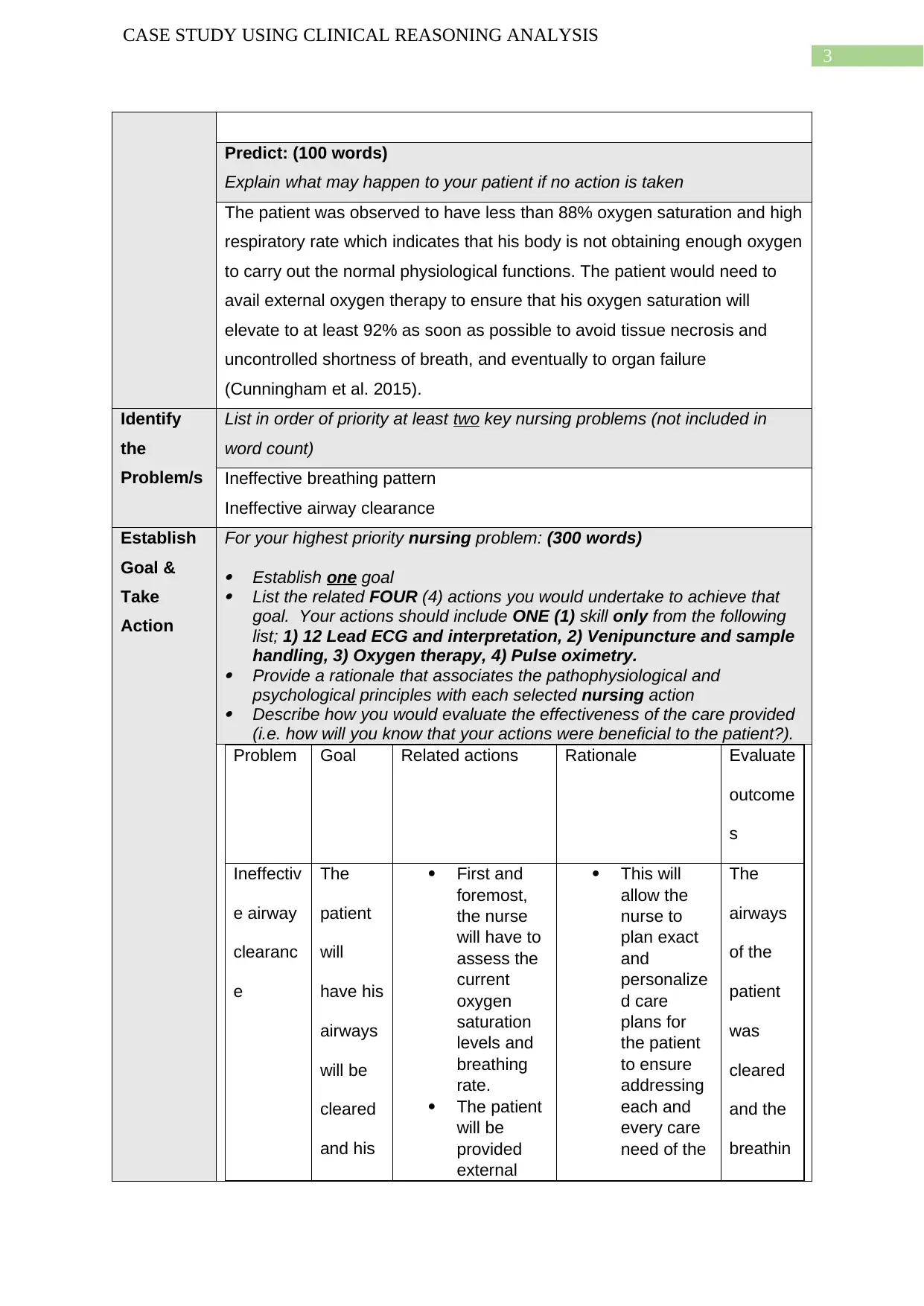
3
CASE STUDY USING CLINICAL REASONING ANALYSIS
Predict: (100 words)
Explain what may happen to your patient if no action is taken
The patient was observed to have less than 88% oxygen saturation and high
respiratory rate which indicates that his body is not obtaining enough oxygen
to carry out the normal physiological functions. The patient would need to
avail external oxygen therapy to ensure that his oxygen saturation will
elevate to at least 92% as soon as possible to avoid tissue necrosis and
uncontrolled shortness of breath, and eventually to organ failure
(Cunningham et al. 2015).
Identify
the
Problem/s
List in order of priority at least two key nursing problems (not included in
word count)
Ineffective breathing pattern
Ineffective airway clearance
Establish
Goal &
Take
Action
For your highest priority nursing problem: (300 words)
Establish one goal
List the related FOUR (4) actions you would undertake to achieve that
goal. Your actions should include ONE (1) skill only from the following
list; 1) 12 Lead ECG and interpretation, 2) Venipuncture and sample
handling, 3) Oxygen therapy, 4) Pulse oximetry.
Provide a rationale that associates the pathophysiological and
psychological principles with each selected nursing action
Describe how you would evaluate the effectiveness of the care provided
(i.e. how will you know that your actions were beneficial to the patient?).
Problem Goal Related actions Rationale Evaluate
outcome
s
Ineffectiv
e airway
clearanc
e
The
patient
will
have his
airways
will be
cleared
and his
First and
foremost,
the nurse
will have to
assess the
current
oxygen
saturation
levels and
breathing
rate.
The patient
will be
provided
external
This will
allow the
nurse to
plan exact
and
personalize
d care
plans for
the patient
to ensure
addressing
each and
every care
need of the
The
airways
of the
patient
was
cleared
and the
breathin
CASE STUDY USING CLINICAL REASONING ANALYSIS
Predict: (100 words)
Explain what may happen to your patient if no action is taken
The patient was observed to have less than 88% oxygen saturation and high
respiratory rate which indicates that his body is not obtaining enough oxygen
to carry out the normal physiological functions. The patient would need to
avail external oxygen therapy to ensure that his oxygen saturation will
elevate to at least 92% as soon as possible to avoid tissue necrosis and
uncontrolled shortness of breath, and eventually to organ failure
(Cunningham et al. 2015).
Identify
the
Problem/s
List in order of priority at least two key nursing problems (not included in
word count)
Ineffective breathing pattern
Ineffective airway clearance
Establish
Goal &
Take
Action
For your highest priority nursing problem: (300 words)
Establish one goal
List the related FOUR (4) actions you would undertake to achieve that
goal. Your actions should include ONE (1) skill only from the following
list; 1) 12 Lead ECG and interpretation, 2) Venipuncture and sample
handling, 3) Oxygen therapy, 4) Pulse oximetry.
Provide a rationale that associates the pathophysiological and
psychological principles with each selected nursing action
Describe how you would evaluate the effectiveness of the care provided
(i.e. how will you know that your actions were beneficial to the patient?).
Problem Goal Related actions Rationale Evaluate
outcome
s
Ineffectiv
e airway
clearanc
e
The
patient
will
have his
airways
will be
cleared
and his
First and
foremost,
the nurse
will have to
assess the
current
oxygen
saturation
levels and
breathing
rate.
The patient
will be
provided
external
This will
allow the
nurse to
plan exact
and
personalize
d care
plans for
the patient
to ensure
addressing
each and
every care
need of the
The
airways
of the
patient
was
cleared
and the
breathin
Secure Best Marks with AI Grader
Need help grading? Try our AI Grader for instant feedback on your assignments.
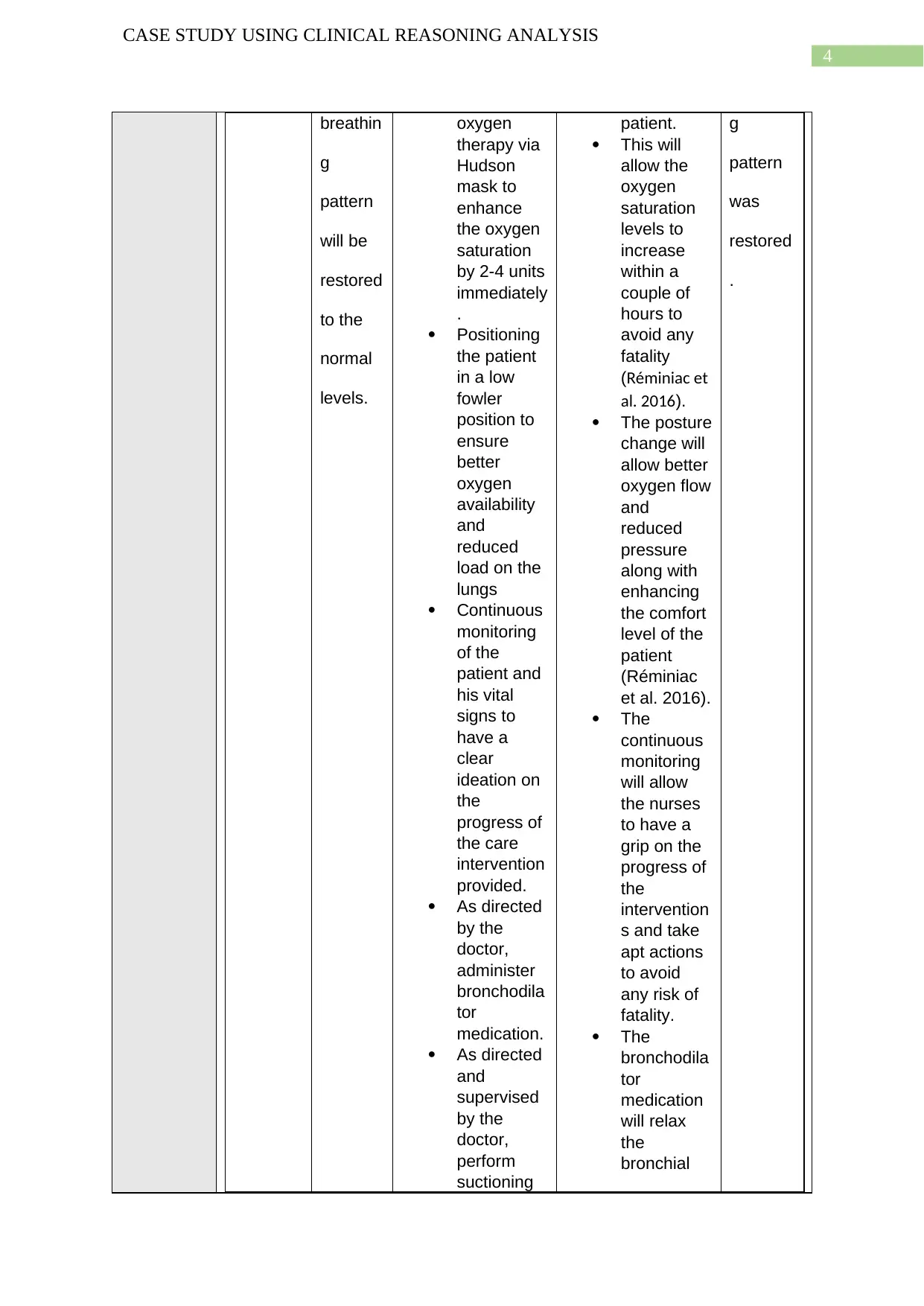
4
CASE STUDY USING CLINICAL REASONING ANALYSIS
breathin
g
pattern
will be
restored
to the
normal
levels.
oxygen
therapy via
Hudson
mask to
enhance
the oxygen
saturation
by 2-4 units
immediately
.
Positioning
the patient
in a low
fowler
position to
ensure
better
oxygen
availability
and
reduced
load on the
lungs
Continuous
monitoring
of the
patient and
his vital
signs to
have a
clear
ideation on
the
progress of
the care
intervention
provided.
As directed
by the
doctor,
administer
bronchodila
tor
medication.
As directed
and
supervised
by the
doctor,
perform
suctioning
patient.
This will
allow the
oxygen
saturation
levels to
increase
within a
couple of
hours to
avoid any
fatality
(Réminiac et
al. 2016).
The posture
change will
allow better
oxygen flow
and
reduced
pressure
along with
enhancing
the comfort
level of the
patient
(Réminiac
et al. 2016).
The
continuous
monitoring
will allow
the nurses
to have a
grip on the
progress of
the
intervention
s and take
apt actions
to avoid
any risk of
fatality.
The
bronchodila
tor
medication
will relax
the
bronchial
g
pattern
was
restored
.
CASE STUDY USING CLINICAL REASONING ANALYSIS
breathin
g
pattern
will be
restored
to the
normal
levels.
oxygen
therapy via
Hudson
mask to
enhance
the oxygen
saturation
by 2-4 units
immediately
.
Positioning
the patient
in a low
fowler
position to
ensure
better
oxygen
availability
and
reduced
load on the
lungs
Continuous
monitoring
of the
patient and
his vital
signs to
have a
clear
ideation on
the
progress of
the care
intervention
provided.
As directed
by the
doctor,
administer
bronchodila
tor
medication.
As directed
and
supervised
by the
doctor,
perform
suctioning
patient.
This will
allow the
oxygen
saturation
levels to
increase
within a
couple of
hours to
avoid any
fatality
(Réminiac et
al. 2016).
The posture
change will
allow better
oxygen flow
and
reduced
pressure
along with
enhancing
the comfort
level of the
patient
(Réminiac
et al. 2016).
The
continuous
monitoring
will allow
the nurses
to have a
grip on the
progress of
the
intervention
s and take
apt actions
to avoid
any risk of
fatality.
The
bronchodila
tor
medication
will relax
the
bronchial
g
pattern
was
restored
.
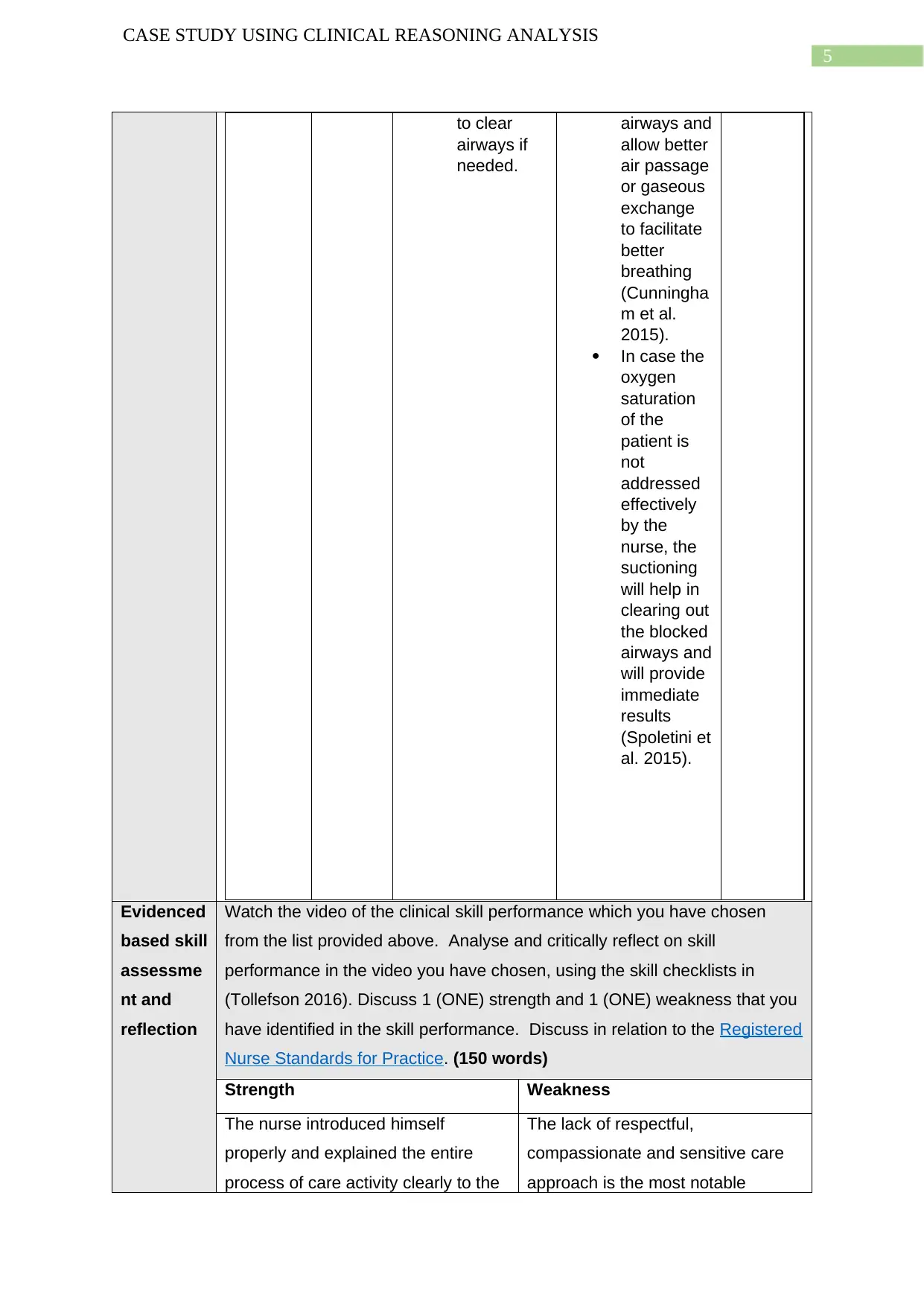
5
CASE STUDY USING CLINICAL REASONING ANALYSIS
to clear
airways if
needed.
airways and
allow better
air passage
or gaseous
exchange
to facilitate
better
breathing
(Cunningha
m et al.
2015).
In case the
oxygen
saturation
of the
patient is
not
addressed
effectively
by the
nurse, the
suctioning
will help in
clearing out
the blocked
airways and
will provide
immediate
results
(Spoletini et
al. 2015).
Evidenced
based skill
assessme
nt and
reflection
Watch the video of the clinical skill performance which you have chosen
from the list provided above. Analyse and critically reflect on skill
performance in the video you have chosen, using the skill checklists in
(Tollefson 2016). Discuss 1 (ONE) strength and 1 (ONE) weakness that you
have identified in the skill performance. Discuss in relation to the Registered
Nurse Standards for Practice. (150 words)
Strength Weakness
The nurse introduced himself
properly and explained the entire
process of care activity clearly to the
The lack of respectful,
compassionate and sensitive care
approach is the most notable
CASE STUDY USING CLINICAL REASONING ANALYSIS
to clear
airways if
needed.
airways and
allow better
air passage
or gaseous
exchange
to facilitate
better
breathing
(Cunningha
m et al.
2015).
In case the
oxygen
saturation
of the
patient is
not
addressed
effectively
by the
nurse, the
suctioning
will help in
clearing out
the blocked
airways and
will provide
immediate
results
(Spoletini et
al. 2015).
Evidenced
based skill
assessme
nt and
reflection
Watch the video of the clinical skill performance which you have chosen
from the list provided above. Analyse and critically reflect on skill
performance in the video you have chosen, using the skill checklists in
(Tollefson 2016). Discuss 1 (ONE) strength and 1 (ONE) weakness that you
have identified in the skill performance. Discuss in relation to the Registered
Nurse Standards for Practice. (150 words)
Strength Weakness
The nurse introduced himself
properly and explained the entire
process of care activity clearly to the
The lack of respectful,
compassionate and sensitive care
approach is the most notable
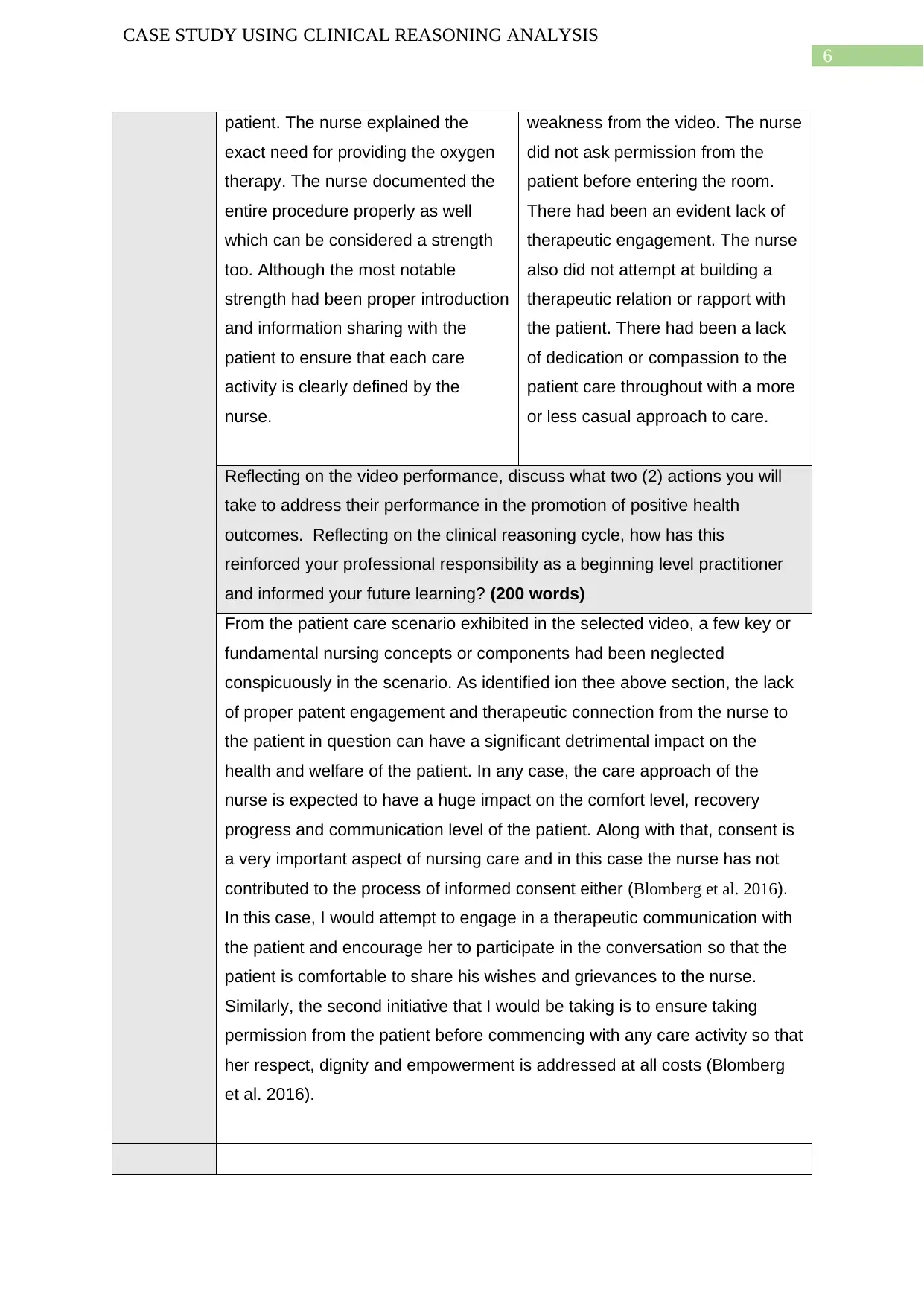
6
CASE STUDY USING CLINICAL REASONING ANALYSIS
patient. The nurse explained the
exact need for providing the oxygen
therapy. The nurse documented the
entire procedure properly as well
which can be considered a strength
too. Although the most notable
strength had been proper introduction
and information sharing with the
patient to ensure that each care
activity is clearly defined by the
nurse.
weakness from the video. The nurse
did not ask permission from the
patient before entering the room.
There had been an evident lack of
therapeutic engagement. The nurse
also did not attempt at building a
therapeutic relation or rapport with
the patient. There had been a lack
of dedication or compassion to the
patient care throughout with a more
or less casual approach to care.
Reflecting on the video performance, discuss what two (2) actions you will
take to address their performance in the promotion of positive health
outcomes. Reflecting on the clinical reasoning cycle, how has this
reinforced your professional responsibility as a beginning level practitioner
and informed your future learning? (200 words)
From the patient care scenario exhibited in the selected video, a few key or
fundamental nursing concepts or components had been neglected
conspicuously in the scenario. As identified ion thee above section, the lack
of proper patent engagement and therapeutic connection from the nurse to
the patient in question can have a significant detrimental impact on the
health and welfare of the patient. In any case, the care approach of the
nurse is expected to have a huge impact on the comfort level, recovery
progress and communication level of the patient. Along with that, consent is
a very important aspect of nursing care and in this case the nurse has not
contributed to the process of informed consent either (Blomberg et al. 2016).
In this case, I would attempt to engage in a therapeutic communication with
the patient and encourage her to participate in the conversation so that the
patient is comfortable to share his wishes and grievances to the nurse.
Similarly, the second initiative that I would be taking is to ensure taking
permission from the patient before commencing with any care activity so that
her respect, dignity and empowerment is addressed at all costs (Blomberg
et al. 2016).
CASE STUDY USING CLINICAL REASONING ANALYSIS
patient. The nurse explained the
exact need for providing the oxygen
therapy. The nurse documented the
entire procedure properly as well
which can be considered a strength
too. Although the most notable
strength had been proper introduction
and information sharing with the
patient to ensure that each care
activity is clearly defined by the
nurse.
weakness from the video. The nurse
did not ask permission from the
patient before entering the room.
There had been an evident lack of
therapeutic engagement. The nurse
also did not attempt at building a
therapeutic relation or rapport with
the patient. There had been a lack
of dedication or compassion to the
patient care throughout with a more
or less casual approach to care.
Reflecting on the video performance, discuss what two (2) actions you will
take to address their performance in the promotion of positive health
outcomes. Reflecting on the clinical reasoning cycle, how has this
reinforced your professional responsibility as a beginning level practitioner
and informed your future learning? (200 words)
From the patient care scenario exhibited in the selected video, a few key or
fundamental nursing concepts or components had been neglected
conspicuously in the scenario. As identified ion thee above section, the lack
of proper patent engagement and therapeutic connection from the nurse to
the patient in question can have a significant detrimental impact on the
health and welfare of the patient. In any case, the care approach of the
nurse is expected to have a huge impact on the comfort level, recovery
progress and communication level of the patient. Along with that, consent is
a very important aspect of nursing care and in this case the nurse has not
contributed to the process of informed consent either (Blomberg et al. 2016).
In this case, I would attempt to engage in a therapeutic communication with
the patient and encourage her to participate in the conversation so that the
patient is comfortable to share his wishes and grievances to the nurse.
Similarly, the second initiative that I would be taking is to ensure taking
permission from the patient before commencing with any care activity so that
her respect, dignity and empowerment is addressed at all costs (Blomberg
et al. 2016).
Paraphrase This Document
Need a fresh take? Get an instant paraphrase of this document with our AI Paraphraser

7
CASE STUDY USING CLINICAL REASONING ANALYSIS
CASE STUDY USING CLINICAL REASONING ANALYSIS
1 out of 8
Related Documents
Your All-in-One AI-Powered Toolkit for Academic Success.
+13062052269
info@desklib.com
Available 24*7 on WhatsApp / Email
![[object Object]](/_next/static/media/star-bottom.7253800d.svg)
Unlock your academic potential
© 2024 | Zucol Services PVT LTD | All rights reserved.





